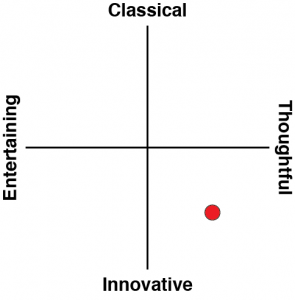The difference between a very fine game, and an inferior, derivative pastiche can at times be very slim. Mato Anomalies is an excellent example of just how fine this line can be. Clearly inspired by Persona, and a novel attempt and bringing a kind of neon-noir approach to the genre, it’s the last five per cent that’s missing from just about every aspect of the game that effectively ruins it.
You play as a detective type that has been recruited by a crime lord type to investigate strange goings-on in the town. Quickly thereafter he discovers that there are “rifts” opening up all over the place, and these rifts are full of deadly enemies where being sucked into one is effectively a death sentence. Fortunately for him, he meets one of the rare warriors that are able to fight in this alternative universe, and so they team up to try and deal with the threat in its entirety. The detective investigates the conspiracies behind the creation of these pocket universes, and then the warrior fights his way through them.
The developers clearly studied Persona closely. It’s blatantly apparent from the very first dungeon, which is themed after the ugly excesses of capitalism and the financial systems. Just as Persona uses its dungeon designs and chapter structure to critically analyse a sequence of social, cultural, or individual themes, so too does Mato Anomalies. It just doesn’t do it as well. The ideas are there, but the execution is not.
Dialogue, for example, is stilted and functional to a fault. There’s never a real sense of character within any of the personalities in the world, and that’s because they’re never given enough to say to establish themselves as personalities. Almost everything in the narrative unfolds like a trail of breadcrumbs with the thinnest exposition to link them together. “Go here, speak to this person. Now go there, speak to that person,” is the kind of wayfinding that occupies so much of your time while playing Mato Anomalies that it quickly becomes exhausting. What little there is with regards to that aforementioned social critique then takes the form of little more than one-liners. To refer back to the first chapter – as everyone knows I’m a strident critic of capitalism. As such, some of the one-liners did give me a reason to laugh. But it was hardly insightful. Later chapters are no better in terms of the depth of discussion, and overall Mato Anomalies hardly offers the persuasive argument in there that, say, Persona 5 makes about the art world, or fashion, and so on and so forth.
It’s not the only area where Mato Anomalies cuts corners. It might sound petty, but the visual transitions between the “real” world and the rift worlds are disjoined and sharp. When your characters win a battle or levels up, the cut back to gameplay is sudden and jarring. These small “cinematic editing fails” give the game a distinctly B-grade presentational quality that it never overcomes in other ways. The interface isn’t particularly user-friendly, and on the Switch, the frame rate jitters so much that even I found it uncomfortable. And I famously had so little issue with the frame rates of the most recent Pokémon games that I still get hate mail over them.
Mechanically it cuts even more corners. The gear system is shallow and uninspired. The party of characters shares a health bar in battle, presumedly to save the developers from needing to track individual health ratings (there’s no real thematic reason for it). Skill upgrades are functional, but plain. You can customise characters to a reasonable extent, but it’s all very 101 stuff. And then, for some truly unimaginable reason, there’s also a card-battling system. Every so often in the “real world” you need to “interrogate” a suspect, and this involves diving into their psyche and playing a simple competitive card game with them.
Why, for a game that was so clearly compromised on budget, did the developers decide that this was the area they wanted to overreach on? The card game is only ever adequate, and certainly not up to the standard of so many other dedicated “TCG-style” games, and so comes off as a development team that was far more ambitious than they had any right to be. Better project management probably would have dropped this from the scope much earlier on.
The one saving grace for the game is the turn-based combat itself. It’s far (far) too easy, but the developers, here, were able to really cleverly balance things so that you needed to make effective use of buffs and debuffs, while also strategically planning out each move you take. Once you use an attack or ability, you’re not able to use it again for several turns – including if you enter another battle – so making sure that you’re well prepared (especially for boss battles) takes a good sense of timing. Of course, the combat system isn’t anywhere near as flashy or dynamic as Persona 5, but if you squint and pretend you’re playing a PS2-era Shin Megami Tensei, then it’s almost passable. It’s certainly the closest this game ever has to finding its groove.
Mato Anomalies had picked the right kind of experience to ape. The Persona series is consistently the most intelligent and thought-provoking in the JRPG genre. The developers have also done a decent effort to understand the thematic basis of those games, and at least attempt their own spin on it. Unfortunately, whether for a lack of resources or an inability to bring the creative elements together cohesively enough, Mato Anomalies’ greatest achievement is simply demonstrating just how hard it really is to make a game like Persona 3, 4 and 5.













